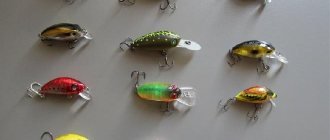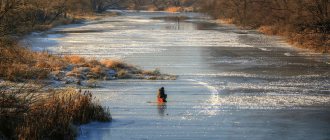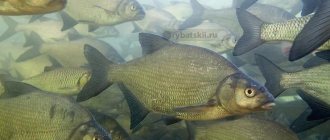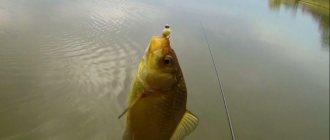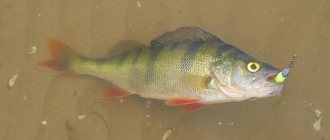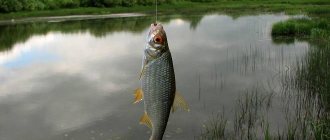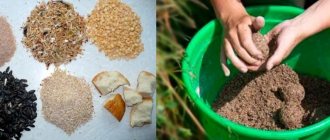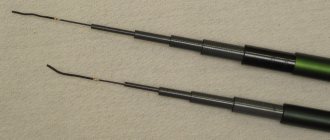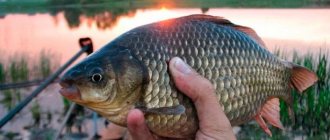author of the article Yuri Zheltyshev
Hello, dear readers of the “School of Fishing”! The name of this fish most likely came from its large, forehead-shaped head, although it is quite possible that the intelligence of this fish was also meant. Indeed, this big-headed fish cannot be denied intelligence and intelligence; it is not so easy to outwit it!
Description, lifestyle of the chub. Distribution, habitats.
Chub is a large, strong and beautiful fish of our rivers. It has a slab-like elongated cylindrical body, adapted for rapid swimming in water and for fighting strong currents. The back of the chub is dark, almost black, the sides are silvery, each scale seems to be edged with a black border. The pelvic fins, as well as the anus, are red-orange in color, the caudal fin is almost black, which makes the chub sharply different from other “white” fish and from the similar ide. The chub's large eyes and large and wide mouth eloquently indicate that this fish is adapted for chasing and grasping a variety of prey, including quite large ones.
At the same time, the chub is not a predator in the full sense of the word, like, for example, the asp. The chub belongs to the so-called semi-predatory fish, that is, it hunts for fry on occasion, but in general it is omnivorous, feeding on both animal and plant food. Moreover, the chub searches for its food in different layers of water; it can feed on both bottom-dwelling organisms (larvae, shells) and insects falling to the surface of the water. The chub has quite powerful pharyngeal teeth, with which it grinds the hard shells of crayfish, snails, and shells.
In summer, the chub eats a lot of mud and algae that grow on snags, but is not averse to snacking on frogs, so it often stands under cliffs from which frogs jump into the water. Closer to autumn, the main food of large chub becomes fry; the chub gives preference to narrow-bodied fish, such as gudgeon. By winter, the chub goes into deep holes, where it falls asleep, however, often, especially in the southern regions, it feeds in the middle of winter, as evidenced by the facts of catching chubs with a winter fishing rod.
Chub spawning takes place differently in different regions, in April-May, but it has been noted that it coincides in timing with the flowering period of bird cherry. Interestingly, during spawning the chub does not lose its appetite and feeds as actively as at other times.
The chub can grow to a decent size, it is said that it can reach 80-90 cm in length and weigh up to 8 kg. Although the records of European countries do not record the capture of such large chubs.
The chub is found almost throughout Europe, both in lowland and mountain rivers (in Italy, for example). It gives preference to rivers with fast-flowing water, with rapids, rifts; it does not tolerate calm, and especially stale water. Therefore, in reservoirs it approaches the mouths of flowing rivers, and sometimes rises high along rivers.
The habitat of the chub is medium and small rivers with running water. In rivers, the chub prefers fast streams of water and a hard-sandy or clay-rocky bottom, but does not like a muddy bottom. The chub cannot be found in bays where there is a lot of dying algae; it loves fast-moving water saturated with oxygen. Rather, it can be found on rapids and rifts, as well as under cliffs and steep ridges, especially in meanders (turns in rivers). It gravitates towards rivers with wooded banks; here it stands for a long time under overhanging bushes and trees, looking out for its prey - caterpillars and other insects falling from branches.
He is extremely wary of the appearance of a person on the river bank, stops paying attention to the food thrown to him, and goes into the depths. However, it does not avoid artificial structures on rivers; on the contrary, it gravitates toward them; it can be found in the “seething area” near dams, under bridges, and pile piers. Apparently, over a long period of existence next to humans, the chub has adapted to life in regulated rivers.
When does the chub bite?
When choosing the time to catch this fish, it is important to take into account the nature of its behavior in a certain season and period of the day.
Chub fishing calendar:
- in the spring. The beginning of active fishing occurs during the period when the water warms up to +15°C. Towards the end of April, the fish begin to prepare for spawning; this period is accompanied by gluttony. In spring and early summer there is a ban on chub fishing; spawning lasts from mid-May to early June;
- in summer. During the day, the fish goes deeper or swims to a shady shore and stands there waiting for falling insects. After the appearance of beetles, dragonflies and butterflies, active fishing takes place on them; other baits are ineffective. In summer, prey tends to be found in fast rivers close to pools, in areas where streams flow into rivers, places with reverse flows, near islands, etc.;
- in the fall. Fish tend to switch to feeding on fry, toads, and crayfish. Nowadays the characteristic “chub fight” is rare, but the fish still feed in the deeper layers. In autumn, the best fishing occurs after the water warms up;
- in winter. Winter fishing is dangerous due to the fact that the fish spend the winter in holes nearby with fast currents; here the ice is not as strong as it seems. On ice, fishing is used with a jig, with a fishing rod with a nod. For the first half hour after drilling, you need to forget about the catch and be patient.
The chub loves places where there are riffles and fast currents.
About the tastes of chub. Nozzles (bait) and lures for catching chub
There is probably no bait or attachment that cannot be used to catch a chub under certain conditions. This fish is truly omnivorous, which is confirmed by the capture of chub on all kinds of baits, sometimes unexpected and exotic. It seems that the chub grabs everything edible that may be in the water. Many authors, starting with Sabaneev, note the diversity of food preferences of the hero of our story, and this was back in those days when our rivers were not so littered with all sorts of garbage.
Chub are caught on a crust of bread, on dough, processed cheese, lard, sausages, on cow liver, raw and boiled, on chicken intestines, on pieces of fish (especially the eye of the herring). It is impossible not to note the natural baits on which the chub is also invariably caught: a variety of insects, flying and crawling, beetles, dragonflies, butterflies, aquatic invertebrates, maggots, all types of worms, leeches, mollusks, crayfish. They also catch frogs with tadpoles and the frogs themselves, but the chub will never miss a fry.
The chub also does not shy away from plant baits, especially in summer: steamed grain, soybeans, peas, chickpeas, pieces of boiled potatoes, filamentous algae, and when the berries ripen, they are also caught using cherry, mulberry, gooseberry and currant berries. Finally, as a semi-predatory fish, chub can be caught using artificial spinning baits - spoons and wobblers - imitations of beetles, frogs and fry.
It would seem that there is so much scope for choosing baits and lures! Catch it - I don’t want it! But it is precisely this abundance of the chub’s food preferences that creates the problem - you never know what the chub will prefer at this particular moment.
Let's talk about the most common baits for catching chub.
Crawling worm . The crawl is a very large worm, sometimes as thick as a finger, dark purple in color with a pink tint. The crawl passages are very deep, so it is useless to dig. Crawlers are collected at night after heavy rain, when the crawlies emerge from their holes to the surface. The crawler stays securely on the hook, it is very tenacious. True, to attach the largest crawlers you have to use a tackle of two hooks. Large chubs bite on the crawl. This is an excellent spring bait.
May beetle or Khrushchev . The emergence of the cockchafer is observed in early May. In the evenings, beetles buzz around the crowns of young trees. It is a large yellow-brown beetle with feathery antennae and black triangular spots on the sides of the abdomen. During the mass flight of the cockchafer, for several days the chub bites only on it. So you shouldn’t miss the moment to fish with this excellent bait.
June Khrushchev and Kuzka bread beetle . The June Khrushchev flies out later than the May one - in June. This beetle is similar to the May beetle, but much smaller in size. Grass beetles can be found on ears of wheat during heading. During the season you can pick up quite a lot of them by walking along the field. Small beetles - June beetles and blackbirds - are placed on the hook in twos.
Butterfly caterpillars . These are the larvae of various butterflies. Among them, the best are medium-sized with delicate, non-hairy covers (green cabbage worms, brown cutworm caterpillars). The fish avoids furry, highly spiny caterpillars. Place the caterpillars carefully, trying not to crush them.
Grasshopper . An excellent summer bait for chub. Grasshoppers appear in June and can be caught in abundance in the meadows. The best ones for catching fish are small short-mustached fillies of a brownish color. When fishing from the surface, the wings of the grasshoppers are straightened, and the rear jumping legs are removed. Only very large fish bite on large green grasshoppers.
Night butterflies . In places where a river flows through a forest, good bait for chub are moths - cutworms, silkworms. These are hairy butterflies with a fat body and short wings. You need to cast them carefully so that the butterfly does not become soft when it hits the water.
Leeches . Various leeches are used for fishing - both large black ones (horse leeches) and small brown ones (klepsina leech). Leeches are collected in lakes, swamps and shallow waters among vegetation. Small leeches can be found on the underside of water lily leaves and on submerged brushwood. Store in a cool place in containers with clean water.
Perlovitsa or toothless . A large bivalve mollusk that lives in flowing reservoirs on sandy soil. The clams are opened with a knife, the fleshy leg is taken out and slightly dried in the sun. Cut into pieces and place on a hook. Well attracts fish that are looking for food at the bottom.
Crayfish . Lives in reservoirs with clean water. You can catch it with a special crayfish trap, putting some kind of odorous bait in it (dead fish, rotten meat). Boiled or raw crayfish meat, especially the tail - “crawfish neck” - is an excellent bait for catching large chub. Very large chub can also be caught using small molting crayfish (with soft covers).
Wheat grains . The most commonly used vegetable bait for catching chub is steamed wheat grains. Wheat is soaked in water for 6-8 hours, then the swollen grains are placed in a linen bag, tied tightly and cooked over low heat for 40 minutes. The finished grains should be soft, but the skin should not burst.
A crust of white bread . The chub is very hungry for white bread. But since the flesh of the bread does not hold well on the hook, the chub is caught on the crust. They pierce the crust and pass a leash with a hook through it (preferably with a tee). This crust holds up well and attracts chub when fishing both on the surface and with a bottom fishing rod.
Specifics of choosing bait for different fishing methods
Depending on the tackle used, the best baits for chub are:
- float tackle: corn, peas, wheat grains, dough, bread crusts, worms;
- bottom tackle: river crustacean, pieces of processed cheese, frogs, corn, peas, grasshopper, clam, white bread;
- fly fishing: grasshopper, cockchafer, butterflies;
- zherlitsy: bread, boiled potatoes, live bait;
- spinning: black or red spinners;
- bombard: artificial baits such as "fly", "gnat" and "bug".
- Garland for winter fishing
- Lucky John Tioga: detailed review
- Bait Breath Mosya – passive food for perch
- Silicone baits from AliExpress
Methods of catching chub in different seasons. Spring fishing for May beetle
It would seem that such a ubiquitous and omnivorous fish like the chub can be caught anywhere and with anything. However, experience shows that it is not so easy to catch a chub. The reason is that the chub is pathologically cautious, it has excellent eyesight and is most often the first to notice the angler.
Experienced fishermen know how difficult it is to persuade distrustful chubs, schools of which can be observed from the steep bank of the river, to bite. If you do not use special camouflage methods when approaching such a place, the chub will never take the bait if it notices a human figure on the shore.
What to do! Fishing for chub requires extreme secrecy and caution from the angler, as well as knowledge of chub habits and tastes. Take, for example, baits for catching chub. The chub menu is so varied that you are simply lost: what to choose? What will the chub prefer at this particular moment - a crust of bread, a worm, a beetle, a caterpillar? Unfortunately, no one knows this except the chub himself! Need to try!
Who would argue that success in catching fish, in particular chub, depends on many factors, not the least of which is the luck of the fisherman. There are happy fishermen for whom everything works out naturally; luck always and everywhere accompanies them. But in addition to luck, you also need skill and knowledge of the habits of this fish - observation, the ability to compare facts, search. Without all of the above, you won’t catch a chub. A lot of articles have been written about catching this fish, but the chub presents us with its own surprises every time.
Each fishing season requires its own approach when catching chub. In spring, summer and autumn, chub behave somewhat differently, which is why catching it in each season differs very significantly. Depending on the temperature, turbidity or transparency of the water, the growth of algae in the water, the chub moves both throughout the reservoir and in different layers of water - sometimes you will find it at the bottom, sometimes half-water, sometimes at the very surface. That’s why the methods of catching chub are so different. In the spring, chub are caught with a bottom fishing rod and reeling, in the summer - with tackle with a long release of the bait, in late summer and autumn - with live bait, with a frog and with a spinning rod.
Chub fishing begins in the spring, still in muddy water. Spring floods drive the chub out of its winter hiding places, and it wanders along the river in search of food. At this time, its food consists of worms, which in large numbers enter the water from washed-out banks and flooded meadows, leeches and other bottom-dwelling organisms. At this time, fishing using bottom gear is productive. Donks are placed in those places where the main current meets the reverse one, where there are edges and ledges at the bottom.
The bait is a crawling worm, sometimes a small fry. Dragonfly larva and leech are also good. Is it easy to catch a chub in muddy water in the spring? Yes and no. In the spring, the chub, hungry over the winter, actively searches for food itself, and takes everything it comes across. But, since in the spring the chub is dispersed throughout the river, it is unknown where to look for it, fishing is done “by luck.”
Another common type of fishing at this time is a half-bottom or bottom with a sliding sinker and an “air” float (the float hangs on a fishing line near the end of the rod). This tackle is designed for catching the “running” chub, which itself prowls back and forth in search of food. The half-bottom consists of a flat sliding sinker and a fairly long leash with a hook. The bait is a worm, a leech, a whitebait.
A variation is the so-called “running donka”. This is, in fact, the same donk, but it is cast using a spinning rod, and the sinker is selected with such a weight that it rolls under the influence of the current. The running donkey is constantly being re-thrown.
The line is pulled in and out in the hope that the bait will eventually find the chub. In this way, most of the river bed can be examined. Of course, the spinning spinner himself (it’s unclear what to call him!) also moves along the river bank, checking the river edges, holes and riffles with his casts. Of course, with such active fishing, frequent hooking of the tackle is possible, so you need to take a large supply of leashes.
In the spring, under steep banks and clay cliffs, where the depth approaches the shore, you can successfully catch chub using a float rod and wire. Of course, the best tackle is “running”, that is, the fishing rod is equipped with guide rings and an inertia-free reel. The float, as a rule, is sliding and has a fairly large carrying capacity (6 or even 10 grams).
This is a so-called float for fishing in currents; floats without a keel and antenna or a disk (flat) float have proven themselves well. The fishing line is no thicker than 0.25 mm, since even in muddy water the chub sees everything perfectly and retains its inherent caution. A leash is required; it must be even thinner in order to preserve all the equipment in case of possible snags and breaks.
The chub grabs the bait, which drags along the bottom, so release the bait a little more than the depth of the reservoir; it is also useful to “hold” the float when the float has swam some distance. It is important to present the bait “right under the nose” of the chub, because during the current the chub stands firmly under its cover and does not want to move anywhere. Fishing is predominantly “travelling”, that is, the focus is on actively searching for fish. The fisherman actively moves along the river bank, casting to places that may be interesting for the chub.
In the spring, the chub, in contrast to its summer preferences, does not come out to the current itself; it clings to the shore where the currents approach the cliffs, looking for some kind of snag like snags and uneven bottom. Also good places are behind long spits, at the exit from pits, where there are “returns” and slowdowns in the flow. The jets at the dam outlets are very, very promising; here the water is enriched with oxygen and always carries some kind of food for the chub. The best places to catch are under the coastal bushes, where there are pressure jets and the fall into the depths begins immediately below the shore.
In the month of May, with the flight of the chafers, the classic period of catching chub with the chafer begins. Khrushchev is an irresistible bait for chub. In those few days that the cockchafer lasts, the chub bites almost exclusively on it. A chub can peck at a beetle all day, but the best time is considered to be the evening dawns, when the beetles fly buzzing over the edges and treetops (Remember from Taras Shevchenko: “The chubs are buzzing over the cherries”?). Fishing continues until complete darkness, with the largest specimens biting closer to night.
How to choose a place for beetle fishing? Any places where chubs can stay are suitable: rapids and streams, capes, bays where two currents meet, river bends, channels between islands. But the best places are where the river flows through the forest, where the fisherman has the opportunity to camouflage himself behind trees and bushes. If the chub does not see the angler, he takes the beetle decisively and boldly.
Gear for catching beetles is gear for fishing with a long release of the bait. A short elastic rod equipped with guide rings (a long one is inconvenient to use among trees), a fishing line with a diameter of 0.25 mm, a transparent ball float, a long 0.2 mm leash with a hook No. 9-12 (according to the international classification). A transparent water-filling float is necessary so that the cautious chub does not suspect anything.
Without a float, the beetle will be difficult to cast, but the chub mistakes such a float for a water bubble and is not afraid of it. The beetle is attached by threading the hook through the underside of the chest, so that the sting comes out on the lower part of the abdomen. Then the beetle falls onto the water naturally - with its belly down, while moving its legs. A bite is indicated by the movement of the float to the side; the hook is not made immediately, but is given time to swallow the beetle.
When this is possible in some places (long capes, ends of islands, bridges, pontoons), and also from a boat, you can catch chub using a cockchafer, releasing the bait far down the river. The ball float is noticeable in the water from afar; you can release it even 50 meters. Along with the chub, other fish, for example, ide and asp, can also bite on the beetle.
When the life of the May beetle ends, you can use other beetles that fly out later for bait - the June beetle (it is much smaller than the May beetle), as well as the kuzka bread beetle, which is found on eared rye. These beetles are placed on a hook in twos, with their backs folded. It is curious that even the Colorado potato beetle is interesting for the chub.
Choosing bait for catching chub
Whether it is necessary to use bait when catching chub directly depends on how well a particular river has been studied. If the reservoir is new, then it is better to quickly explore the area than to try to attract fish to a certain point to no avail. In the case when the site of this representative is found, the bait has a fairly high effectiveness.
Did you know? Catching fish when the bait is your own hand is called “noodling”. Catfish are usually hunted this way.
The type of dietary supplement will depend on the season:
- spring - animal ingredients are required, minced meat based on chicken liver, chopped worms and soil from the coastline is used;
- summer - vegetable compositions with large fractions of boiled peas and cereals, as well as chopped worms or bloodworms;
- autumn - summer composition is changed so that the mass part of animal components exceeds plant components.
The feeding technique will depend on the fishing range. If the bait will be located far from the shore, then it is best to use a closed-type feeder. At close distances, they form balls from food and throw them with a slingshot at a distance of 3–4 m upstream. In summer, baits are used .
To do this, bread fried in oil, potato peelings, steamed cereals and chopped worms are placed in a stocking without holes. The stocking is tied to a thread, at the end of which a foam buoy is located. Then this bait is immersed in water. Once every 3 days, change the internal contents to fresh ones. This approach helps attract fish through smell.
Summer fishing for chub on a float rod with long-distance bait release. Catching chub with bait.
Summer chub fishing is very diverse. The chub constantly moves in the water column throughout the day, these movements must be taken into account. At night and in the mornings, large chub approach the shore, especially in places where there are changes in depth and grassy thickets. During the day on sunny days, the chub stands for a long time in the shade of trees hanging over the water, waiting for falling living creatures - bugs, caterpillars, moths.
You can also find chub under cliffs, where the chub lies in wait for frogs jumping from the cliff. Another classic summer resting place for chub is grassy riffles (the beginning of the riffle and the entrance to the riffle hole). It is worth paying attention that the chub riffle should have an uneven bottom - with boulders, grass bushes, snags. On a clear bottom, there is nothing for the fish to hide behind, so there are no chubs on such riffles.
On summer days, a wide variety of insects fly out - butterflies, dragonflies, mayflies. During the mass emergence of mayflies, the chub refuses to take other baits and picks up only these “ethereal” creatures from the surface.
Perhaps only fly fishing with its weightless flies - imitations of various dipterans can stir up the chub at this time. By the way, the chub can be classified as almost the only “fly fishing fish”, of course, in those places where there are no trout. Fly fishing has been and remains one of the most effective summer chub fishing gear, and besides, this fishing is very sporting, it’s a pity that it is not yet very common in our country.
By mid-June, at the beginning of haymaking, grasshoppers appear. There are two main types of grasshoppers: large green long-whiskered grasshoppers with a sword-shaped ovipositor and smaller short-whiskered grasshoppers with a brownish color. Both are suitable for chub fishing, but only very large fish bite on large green grasshoppers. Small grasshoppers can be hooked two at a time; large grasshoppers have their long back legs (jumping legs) torn off.
Sometimes grasshoppers spread their wings to imitate their “gliding” towards the water. If you can cast very softly, the bite may occur at the very moment the insect splashes down. Fishing for a grasshopper is not fundamentally different from fishing for a cockchafer - the grasshopper is floated downstream. Float tackle is used for long-distance fishing with bait with a transparent ball float.
An interesting way of catching chub using insects is the “bale”. Two spinning rods are connected with one fishing line, and long leashes, about a meter in length, are suspended from the fishing line in the middle. Various flying insects are placed on leashes - dragonflies, butterflies, grasshoppers. Two spinners, being on different banks of a river or channel, “bale” leashes on the surface of the water. If secrecy is observed, then sooner or later the chub will grab the tempting bait. This method is very spectacular and sporty.
In summer, the chub also begins to take on plant baits. You can catch it on steamed peas, on wheat, on a crust of bread, both with a float and a bottom fishing rod. When to use which tackle is up to the fisherman himself; it depends primarily on the weather. Sabaneev also noticed that the clearer the weather, the higher the chub stands, and in cold and rainy weather the chub sinks to the bottom. Then they move on to bottom fishing. Donka is also indispensable for night fishing.
In cold weather, when the chub is difficult to detect, you can bait it with balls of bait containing animal and plant components (porridge, crushed shells, maggots). This is done in places with calmer water - behind trees lying across the current, in small pools.
You can fish in a baited area using a variety of summer baits: bread, processed cheese, dough, wheat, crayfish, maggot. Sabaneev mentions such unusual attachments as cherries and currants. A leash is passed through the cherry using a nozzle needle; it is interesting that not only fresh cherries are used, but also canned ones.
By the end of summer, the chub is increasingly displaying its predatory instincts, which means you can catch it with live bait and a live frog. Since bottom fishing with live bait is not very sporting, and is also inhumane, let’s talk about fishing with artificial bait - about fishing with a spinning rod.
Summer diet
In summer, the warmer it is, the more insects make up the chub’s diet, and this is the period from June to August. It is precisely those representatives that reach the surface that the fish love, resisting specimens that may end up on the bottom. This also applies to butterflies, grasshoppers, dragonflies, and caterpillars that fall from bushes into the water. If the caterpillars are too furry, they ignore them. Green cabbages have an advantage; the larger they are, the better (the catch will be noticeably larger).
If you take maggots and larvae, you can only catch small fish. If there is a gossamer (dragonfly larva) or an omentum (chafer beetle), a large specimen will swim. Catching chub using the cockchafer is especially important during this period.
You should not expect that fish will be caught immediately with the start of the summer season. You need to watch for grasshoppers - bait No. 1. If they have grown well, then you can start your fishing hunt, because they are the species most desirable to catch. The grasshopper is also suitable for fishermen, as it holds the hook well and is suitable for long-distance casting.
In summer, the heat factor should be taken into account. It negatively affects the bite during the day. Since moths and shore ducks often appear during this period, the chub actively feeds on them at night and rests during the day. That is, you should fish when it’s not hot.
Catching chub with a spinning rod. Preferred baits: spinners and wobblers
Spinning chub fishing is one of the most sporting and exciting types of fishing. It brings a lot of emotions, requires the spinner to know where the chub hangs, the ability to make accurate and lightning-fast casts, and mastery of the entire arsenal of modern spinning lures and methods of their animation.
Those who tried to catch chub with a spinning rod from the shore were most likely disappointed in such fishing. The chub is a cautious fish; it does not bite when it suspects even the slightest danger. When he sees a spinner approaching the water's edge, he usually hides. It is best to catch chub from a boat floating freely with the current. Apparently, the chub does not wait for danger from the water, it observes mainly the shores, responds to the stomping of feet, and a boat floating through the water without splashes has a better chance of not scaring away the cautious fish.
The fishing technique here is as follows: you sail on a boat at the speed of the current, trying to assess by eye the places where the chub may be staying. Baits should be thrown under the cliffs to the very edge of the water (the chub stands under the cliff and waits for frogs jumping from above), or under bushes hanging over the water, behind snags or fallen trees. Often the chub grabs the bait reflexively; many bites occur at the moment when the bait touches the surface of the water.
This tactic can be called the “first cast tactic”, because as a rule, the chub either bites on the first two casts or does not bite at all. Further fishing of the place does not give results - fish for at least an hour, at least two. As soon as the chub notices the presence of an angler, it hides for a long time.
The same thing happens after a large fish leaves, after the bait is released from the hook, from branches hanging over the water. You can safely swim further from this place - the chub will no longer take you here. Therefore, you need to be extremely collected, send the bait as accurately as possible, placing it not on a snag, but nearby. Jewelry precision is not necessary, but desirable. You need to at least imagine where the chub might be hiding at the moment.
Here are the areas on the river that should be fished first:
- steep banks of the river, especially at bends and turns, islands of grass near the cliffs;
- wooded areas with trees hanging over the water, trees and bushes that have fallen into the water;
- water lily fields, especially if they border whirlpools and reverse currents;
- riffles, especially grassy ones, with long tufts of grass and algae, the transition of a riffle into a riffle hole;
- areas of reverse current behind capes and islands, especially if there are grass bushes and bottom ledges;
- seething streams below dams, piles of old bridges;
- confluences of small rivers and streams.
It is precisely these places that the chub chooses for its camps; here it waits for what the current will bring it. Of course, sometimes in such places you can find not only chub, but also other fish, but that’s what makes fishing interesting because sometimes surprises await us.
Now about lures for catching chub. There are many baits, but they can all be divided into two categories - spinners and wobblers.
Spoons - spinners are very effective for catching chub; it’s hard to even say what the fish mistake them for. We need small and medium-sized spinners (No. 0 - No. 2) from good companies, such as MEPPS, MYRAN, BLUE FOX.
For some reason, the chub prefers the black and gold colors of the petals of the spinners. For example, a Mepps spinner of Black Furi color is considered a chub - a black petal with orange spots. The golden spinner MYRAN Panter martin Golden No. 3 is also good. The following rule applies: small spoons attract mainly small chubs, medium spoons attract medium chubs, and for some reason large spoons alert the chub. Therefore, anyone who wants to catch a really large chub should use wobblers.
Wobbler fishing for chub is a whole page in the history of spinning fishing. Most often, small fat wobblers of the “fat” shape are recommended for chub. Many companies have similar models. The most famous among them: Owner Cultiva Bug Eye, SMITH Camion, JACKALL Chubby, ZIP BAITS Hiscory, KOSADAKA Roger surf, STRIKE PRO Warted Toad. The chub eats these wobblers of “well-fed geometry” for their dear soul; bites are often reflexive, that is, at the moment the bait splashes down.
Some companies have wobblers that imitate water swimming beetles, for example, River2Sea, these wobblers are also attractive to chub. It is impossible not to mention the Salmo Hornet, this wobbler in the Black Tiger color resembles a black water beetle, and the small wobbler Salmo Tiny is an almost exact copy of the May beetle.
Some small minnow-shaped wobblers that imitate small fish have also proven themselves to be quite good: OWNER CULTIVA Rip'n Minnow 65, YO-ZURI Crystal Minnow, DAIWA Shiner 1062 SP. The L-Minnow 44 Sinking wobbler from the YO-ZURI company has simply become a celebrity; it has been noticed that not only predatory fish, but also white fish, bite on it. You can also mention the well-tested Rapala Glass Shad Rap 4 cm, Owner Cultiva MiraShad 5 cm and Arms Shad Micro 5 cm.
The chub takes all these wobblers with Shad geometry without fail, the only pity is that you often come across small chubs, which naturally must be released. And if you want to catch a trophy chub, use something more solid, like Yo-Zuri Hardcore WO-B-RU-1. Wobblers must be selected not only by their size and shape, but, above all, by their depth of immersion, because the chub stands in different layers of water at different times.
As you can see, a chub spinner has a lot of wonderful baits in his arsenal. Catching chub with wobblers can be so catchy that it makes sense to warn chub hunters - don’t get carried away! Do not turn noble fishing into fishing - a competition with beautiful and gambling fish!
Choosing a fishing spot
The chub prefers areas with a hard bottom texture - clayey, pebble, sandy, rocky. More often, its sites can be observed under steep yars, as well as in the shade of trees hanging over the water and in various secluded areas where it is convenient to wait for prey. They mainly catch chub on small and medium-sized rivers with a width of 20–60 m.
- Promising areas in such reservoirs:
- reverse flow;
- flow boundaries;
- rifts and wide reaches behind them;
- entrances/exits from recesses;
- dumps under steep areas;
- bushes and fallen trees hanging over the water;
- sharp turns of the channel in parts where the streams are almost adjacent to the coastline;
- shallows bordering the dump to the depth where the stream flows;
- flow under bridges and other water structures.
About the sports principle “Catch and release!”
Chub fishing is a real pleasure for the angler. The pleasure is in finding this cautious fish, getting close to it unnoticed within casting distance, finding a bait or bait that suits its taste today, and outsmarting it, enticing it to bite. What about the bite itself? Those who have experienced a chub bite on a spinning rod - this crushing blow, from which the whip almost flies out of their hands - will never forget this moment!
Fishing for a chub with its somersaults, somersaults, and powerful splashes is also an unforgettable event. And the moment of triumph of the fisherman is indescribable, when the handsome red-finned fish, which was cutting the water with a silver torpedo, finally calms down, and, pacified, allows itself to be led to the boat itself.
In a word, chub fishing is a real competition with smart, strong, beautiful fish. Even catching a kilogram chub becomes an event, let alone catching a handsome one weighing 2-3 kg! It's just a torpedo on a fishing line, a radio-controlled rocket!
Only here’s the problem: such handsome gravitans have become rare on our rivers. Therefore, it would be most correct if, after admiring the living silver of a caught trophy, we take it and give it life. Believe me, the sports happiness from your victory will not decrease, but increase! After all, you will receive double joy - the joy of fighting and capturing, and the joy of giving life! Learn to respect your worthy opponent, who brought you the joy of biting and fishing.
Chub is a true decoration of our rivers! So let’s treat living beauty in a sporting, noble manner. The defeated opponent must be knightly given his life. Agree, you can eat pilengas bought at the market, right? And the chub is too valuable a sport fish to catch only once.
And believe me, this is not a whim, not an eccentricity; serious chub hunters naturally come to such thoughts. After all, they understand that not a single fish is capable of delivering so many emotions to the angler - with its amazing bite-strike, its ability to fight and not give up!
Let him live and delight us with bites again!
text and photo by Yuri Zheltyshev
What do you use to catch chub?
Considering the omnivorous nature of the chub, you can catch it with almost any equipment: a float rod, spinning rod, bottom tackle and fly fishing. At the same time, the choice of baits and artificial baits is simply huge.
Read more
How to catch trout with a bombard?
Nozzles can be:
- bread;
- corn;
- peas;
- steamed grains of wheat or pearl barley;
- cheese;
- chicken liver and other entrails;
- pieces of lard, meat, sausage or frankfurters;
- whole cherries and mulberries.
The following are used as bait:
- worm - earthworm or crawling;
- live bait - preferably with a narrow body (bleak, minnow or minnow);
- frog;
- leech;
- various insects during their emergence (especially the May beetle and grasshoppers).
Worm for bait
Many traditional baits for catching chub are no longer used due to their low availability:
- crayfish meat;
- blood clots;
- lamprey larva.
